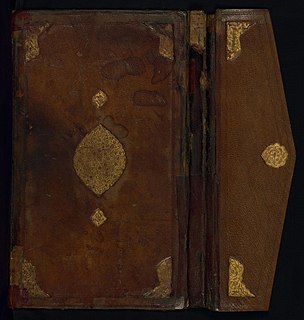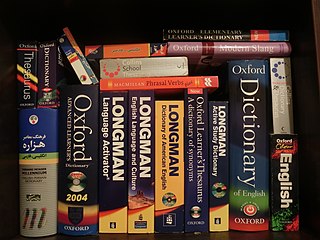
A glossary, also known as a vocabulary or clavis, is an alphabetical list of terms in a particular domain of knowledge with the definitions for those terms. Traditionally, a glossary appears at the end of a book and includes terms within that book that are either newly introduced, uncommon, or specialized. While glossaries are most commonly associated with non-fiction books, in some cases, fiction novels may come with a glossary for unfamiliar terms.

Mithra is the Zoroastrian angelic Divinity (yazata) of Covenant, Light, and Oath. In addition to being the divinity of contracts, Mithra is also a judicial figure, an all-seeing protector of Truth, and the guardian of cattle, the harvest, and of the Waters.

Middle Persian literature is the corpus of written works composed in Middle Persian, that is, the Middle Iranian dialect of Persia proper, the region in the south-western corner of the Iranian plateau. Middle Persian was the prestige dialect during the era of Sassanid dynasty.

The Dēnkard or Dēnkart is a 10th-century compendium of the Mazdaen Zoroastrian beliefs and customs. The Denkard is to a great extent an "Encyclopedia of Mazdaism" and is a most valuable source of information on the religion. The Denkard is not itself considered scripture.
Frahang-ī Pahlavīg is the title of an anonymous dictionary of unknown date of (mostly) Aramaic logograms with Middle Persian translations and transliterations. The glossary was previously known to Indian Zoroastrians as the mna-xvatay, a name derived from the first two words of the first entry/lemma. The Frahang-i Pahlavig should not be confused with the Frahang-i Oim-evak, which is a glossary of Avestan language terms.

The Faravahar, also known as Farr-e Kiyani, is one of the best-known symbols of Iran. It symbolizes Zoroastrianism, the first religion of Iran before the Arab invasion of Iran, and Iranian nationalism.

Vohu Manah is the Avestan language term for a Zoroastrian concept, generally translated as "Good Purpose", "Good Mind", or "Good Thought", referring to the good moral state of mind that enables an individual to accomplish his duties. Its Middle Persian equivalent, as attested in the Pahlavi script texts of Zoroastrian tradition, is Wahman, which is a borrowing of the Avestan language expression and has the same meaning, and which continues in New Persian as Bahman and variants. Manah is cognate with the Sanskrit word Manas suggesting some commonality between the ideas of the Gathas and those of the Rigveda. The opposite of Vohu Manah is Aka Manah, "evil purpose" or "evil mind".

The Avestan alphabet is a writing system developed during Iran's Sassanid era (226–651 CE) to render the Avestan language.
In the Western world, Persia was historically the common name for Iran. On the Nowruz of 1935, Reza Shah Pahlavi asked foreign delegates to use the term Iran, the endonym of the country, in formal correspondence. Since then, in the Western World, the use of the word "Iran" has become more common. This also changed the usage of the terms for Iranian nationality, and the common adjective for citizens of Iran changed from "Persian" to "Iranian". In 1959, the government of Mohammad Reza Shah Pahlavi, Reza Shah Pahlavi's son, announced that both "Persia" and "Iran" could officially be used interchangeably. However the issue is still debated today.

The Book of Ardā Wīrāz is a Zoroastrian religious text of the Sasanian era written in Middle Persian. It contains about 8,800 words. It describes the dream-journey of a devout Zoroastrian through the next world. The text assumed its definitive form in the 9th-10th centuries after a long series of emendations.
Pahlavi or Pahlevi is a particular, exclusively written form of various Middle Iranian languages. The essential characteristics of Pahlavi are

The Iranian or Iranic languages are a branch of the Indo-Iranian languages in the Indo-European language family that are spoken natively by the Iranian peoples.

Pazend or Pazand is one of the writing systems used for the Middle Persian language. It was based on the Avestan alphabet, a phonetic alphabet originally used to write Avestan, the language of the Avesta, the primary sacred texts of Zoroastrianism.
Garshāsp was a mythical Iranian king. He was a descendant of Zaav and ruled over Iran about nine years. and is the name of a monster-slaying hero in Iranian mythology. The Avestan form of his name is Kərəsāspa and in Middle Persian his name is Kirsāsp.

Bundahishn /bʊndaˈhɪʃn/ Avestan: 𐬠𐬎𐬥 𐬛𐬀𐬵𐬌𐬱𐬥𐬍𐬵 Bun-dahišnīh, meaning "Primal Creation", is the name traditionally given to an encyclopediaic collection of Zoroastrian cosmogony and cosmology written in Book Pahlavi. The original name of the work is not known.
Khordeh Avesta, meaning 'little, or lesser, or small Avesta', is the name given to two different collections of Zoroastrian religious texts. One of the two collections includes the other and takes its name from it.

The Zand-i Wahman Yasn is a medieval Zoroastrian apocalyptical text in Middle Persian. It professes to be a prophetical work, in which Ahura Mazda gives Zoroaster an account of what was to happen to the behdin and their religion in the future. The oldest surviving manuscript is from about 1400, but the text itself is older, written and edited over the course of several generations.
Avestan geography is the compilation of the geographical references in the Avesta which are limited to the regions on the eastern Iranian plateau up to Indo-Iranian border. It was common among the Indo-Iranians to identify concepts or features of traditional cosmography—mountains, lakes, rivers, etc.—with their concrete historical and geographical situation as they migrated and settled in various places.




